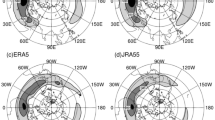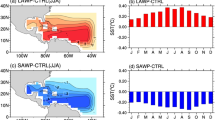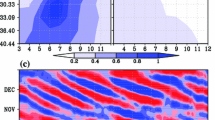Abstract
The atmospheric general circulation models ARPEGE-climate and LMDz are used in an aquaplanet configuration to study the response of a zonally symmetric atmosphere to a range of sea surface temperature (SST) forcing. We impose zonally-symmetric SST distributions that are also symmetric about the equator, with varying off-equatorial SST gradients. In both models, we obtain the characteristic inter-tropical convergence zone (ITCZ) splitting that separates two regimes of equilibrium (in terms of precipitations): one with one ITCZ over the equator for large SST gradients in the tropics, and one with a double ITCZ for small tropical SST gradients. Transition between these regimes is mainly driven by changes in the low-level convergence that are forced by the SST gradients. Model-dependent, dry and moist feedbacks intervene to reinforce or weaken the effect of the SST forcing. In ARPEGE, dry advective processes reinforce the SST forcing, while a competition between sensible heat flux and convective cooling provides a complex feedback on the SST forcing in the LMDz. It is suggested that these feedbacks influence the location of the transition in the parameter range.













Similar content being viewed by others
References
Back LE, Bretherthon CS (2008) On the relationship between SST gradients, boundary layer winds and convergence over the tropical oceans. J Clim 22:4182–4196
Barsugli J, Shin SI, Sardeshmukh PD (2005) Tropical climate regimes and global climate sensitivity in a simple setting. J Atmos Sci 62:1226–1240
Belamari S, Pirani A (2007) Validation of the optimal heat and momentum fluxes using the ORCA2-LIM global ocean–ice model. Marine environment and security for the european areaintegrated project (MERSEA IP), deliverable D4.1.3, p 88
Bellon G, Sobel AH (2010) Multiple equilibria of the Hadley circulation in an intermediate–complexity axisymmetric model. J Clim 23:1760–1778
Bjerknes J (1969) Atmospheric teleconnections from the equatorial Pacific. Mon Weather Rev 97:163–172
Bony S, Emanuel JL (2001) A parameterization of the cloudiness associated with cumulus convection; evaluation using TOGA COARE data. J Atmos Sci 58:3158–3183
Bougeault P (1985) A simple parameterisation of the large scale effects of cumulus convection. Mon Weather Rev 4:469–485
Chao WC, Chen B (2004) Single and double ITCZ in an aqua-planet model with constant sea surface temperature and solar angle. Clim Dyn 22:447–459
Charney JG (1971) Tropical cyclogenesis and the formation of the ITCZ. In: Reid WH (ed) Mathematical problems of geophysical fluid dynamics, vol 13, American Mathematical Society, USA, pp 355–368
Cuxart J, Bougeault P, Redelsperger J (2000) A turbulence scheme allowing for mesoscale and large-Eddy simulations. Q J R Meteorol Soc 126:1–30
Dai AG (2006) Precipitation characteristics in 18 coupled climate models. J Clim 19:4605–4630
Déqué M, Dreveton C, Braun A, Cariolle D (1994) The ARPEGE/IFS atmosphere model: a contribution to the French community climate modelling. Clim Dyn 10:249–266
Dijkstra HA, Neelin JD (1995) Ocean–atmosphere interaction and the tropical climatology. Part II: why the Pacific cold tongue is in the east? J Clim 8:1343–1359
Dufresne JL et al. Climate change projections using the IPSL-CM5 earth system model: from CMIP3 to CMIP5. Clim Dyn (submitted)
Emanuel KA (1991) A scheme for representing cumulus convection in large-scale models. J Atmos Sci 48:2313–2335
Fouquart Y, Bonnel B (1980) Computations of solar heating of the earths atmosphere: a new parametrization. Contrib Atmos Phys 53:35–62
Gill AE (1980) Some simple solutions for heat-induced tropical circulation. Q J R Meteorol Soc 106:447–462
Hess PG, Battisti DS, Rasch PJ (1993) Maintenance of the intertropical convergence zones and the tropical circulation on a water-covered earth. J Atmos Sci 50:691–713
Holton JR, Wallace JM, Young JA (1971) On boundary layer dynamics and the ITCZ. J Atmos Sci 28:275–280
Holloway CE, Neelin JD (2007) The convective cold top and quasi equilibrium. J Atmos Sci 64:1467–1487
Hourdin F et al (2006) The LMDZ4 general circulation model: Climate performance and sensitivity to parametrized physics with emphasis on tropical convection. Clim Dyn 27:787–813
Hubert LF, Krueger AF, Winston JS (1969) The double intertropical convergence zone-fact or fiction. J Atmos Sci 26:771–773
Kirtman BP, Schneider EK (2000) A spontaneously generated tropical atmospheric general circulation. J Atmos Sci 57:2080–2093
Lin JL (2007) The double-ITCZ problem in IPCC AR4 coupled GCMs: ocean atmosphere feedback analysis. J Clim 18:4497–4525
Lindzen RS (1974) Wave-CISK in the tropics. J Atmos Sci 31:156–179
Lindzen RS, Nigam S (1987) On the role of the sea surface temperature gradients in forcing the low-level winds and convergence in the tropics. J Atmos Sci 44:2418–2436
Liu Y, Guo L, Wu G, Wang Z (2009) Sensitivity of the ITCZ configuration to cumulus convective parametrizations on an aquaplanet. Clim Dyn 34:223–240
Louis JF (1979) A parametric model of vertical eddy fluxes in the atmosphere. Boundary Layer Meteorol 17:187–202
Mechoso CR and Coauthors (1995) The seasonal cycle over the tropical Pacific in coupled oceanatmosphere general circulation models. Mon Weather Rev 123:2825–2838
Mlawer EJ, Taubman SJ, Brown PD, Iacono MJ, Clough SA (1997) Radiative transfer for inhomogeneous atmospheres: RRTM, a validated correlated-k model for the longwave. J Geophys Res 102:16663–16682
Morcrette JJ, Smith L, Fouquart Y (1986) Pressure and temperature dependence of the absorption in longwave radiation parametrizations. Contrib Atmos Phys 59(4):455–469
Neale RB, Hoskins BJ (2000a) A standard test for AGCMs including their physical parameterizations: I: the proposal. Atmos Sci Lett 1:101–107
Neale RB, Hoskins BJ (2000b) A standard test for AGCMs including their physical parameterizations—II: results for the met office model. Atmos Sci Lett 1:108–114
Numaguti A (1993) Dynamics and energy balance of the Hadley circulation and the tropical precipitation zones: significance of the distribution of evaporation. J Atmos Sci 50:1874–1887
Philander SGH, Gu D, Halpern D, Lambert G, Lau NC, Li T, Pacanowski RC (1996) Why the ITCZ is mostly north of the equator? J Clim 9:2958–2972
Ricard JL, Royer JF (1993) A statistical cloud scheme for use in an AGCM. Ann Geophys 11:1095–1115
Schneider EK (2002) Understanding differences between the equatorial Pacific as simulated by two coupled GCMs. J Clim 15:449–469
Voldoire A et al (2011) The CNRM-CM5.1 global climate model: description and basic evaluation. Clim Dyn (in press)
Waliser DE, Somerville RCJ (1994) The preferred latitudes of the intertropical convergence zone. J Atmos Sci 51:1619–1639
Xie SP, Philander SGH (1994) A coupled ocean-atmosphere model of relevance to the ITCZ in the eastern Pacific. Tellus 46A:340–350
Zhang XH, Lin WY, Zhang MH (2007) Toward understanding the double intertropical convergence zone pathology in coupled oceanatmosphere general circulation models. J Geophys Res 112:D12102. doi:10.1029/2006JD007878
Acknowledgments
The authors would like to thank Aurore Voldoire, Sophie Tytecas and Antoinette Alias for their help on the CNRM-CM5 model. We also would like to thank Florent Brient, Laurent Fairhead and Musat Ionela for their help on the IPSL-CM5A model. Thanks are extended to Sandrine Bony, Laurent Li, Hervé Douville, Jean-Luc Redelsperger for helpful discussions throughout the course of this work. Thanks are also due to the editor and reviewers for their helpful comments.
Author information
Authors and Affiliations
Corresponding author
Additional information
This paper is a contribution to the special issue on the IPSL and CNRM global climate and earth system models, both developed in France and contributing to the 5th coupled model intercomparison project.
Rights and permissions
About this article
Cite this article
Oueslati, B., Bellon, G. Tropical precipitation regimes and mechanisms of regime transitions: contrasting two aquaplanet general circulation models. Clim Dyn 40, 2345–2358 (2013). https://doi.org/10.1007/s00382-012-1344-x
Received:
Accepted:
Published:
Issue Date:
DOI: https://doi.org/10.1007/s00382-012-1344-x




